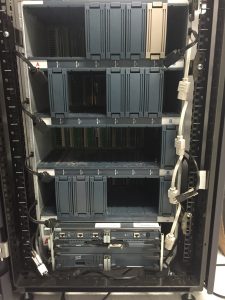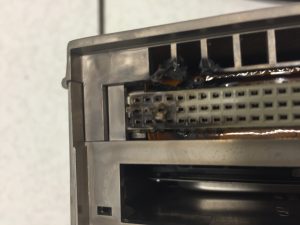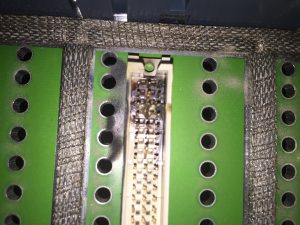 At work, we are in the middle of commissioning 4400 sq ft of new data centre space. We are probably 60 days away from being ready for paying clients, but that’s not stopping me from bringing in some of my ‘toys’ from the garage and give them a nice air-conditioned home.
At work, we are in the middle of commissioning 4400 sq ft of new data centre space. We are probably 60 days away from being ready for paying clients, but that’s not stopping me from bringing in some of my ‘toys’ from the garage and give them a nice air-conditioned home.
One of these ‘toys’ is a BA370/HSZ80 hard drive array, which is going to get connected to my AlphaServer ES40. This drive array is massive – it takes up probably about 18U of rack space.
After several hours of disassembly, packing, transport, unpacking, and re-assembly, I power up the array to make sure everything survived the trip.
CRACKLE! Hmm. What was that? I switched the power off, and pulled out the five power supplies. I gave each of them the ‘sniff test’ to make sure they weren’t the source of the sound. Now is where I made my mistake. I decided I should put the supplies back in and power back up. Wow! What a smoke show! The eight high-powered fans on the back of the unit belched out smoke like a steam engine, and the room was instantly filled with the acrid smell of burning electronics.
It’s this point in time that I remember the dual pre-action sprinkler system in the data centre. The last thing I need is to trigger that! Thankfully, I was able to pull the power and quickly open every door to the facility to try to let in fresh air (not the normal mode of operation for a data centre – normally they operate as a closed system recirculating filtered air)
 Time to inspect the damage. After pulling the drive modules, I quickly discover the source. The pins of one of the connectors must have got bent when inserting a drive module. I am shocked at the level of damage. It looks like the plastic enclosure of the drive module literally caught fire. It’s a little concerning knowing the entire assembly is made from such flammable plastic.
Time to inspect the damage. After pulling the drive modules, I quickly discover the source. The pins of one of the connectors must have got bent when inserting a drive module. I am shocked at the level of damage. It looks like the plastic enclosure of the drive module literally caught fire. It’s a little concerning knowing the entire assembly is made from such flammable plastic.
 Next, I have to totally disassemble the backplane so that I can get to the damaged socket and clean everything up. I have an abundance of slots in this array, so I’m not overly concerned about losing a slot, but I want to make sure that there’s no permanent damage to the backplane other than a bad socket.
Next, I have to totally disassemble the backplane so that I can get to the damaged socket and clean everything up. I have an abundance of slots in this array, so I’m not overly concerned about losing a slot, but I want to make sure that there’s no permanent damage to the backplane other than a bad socket.
It looks like I’ve got a bit of work ahead of me. Oh well. Repairs are the best part of retro computing, right?
